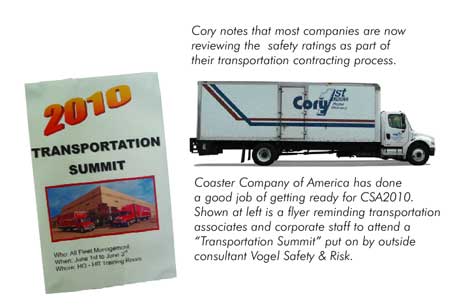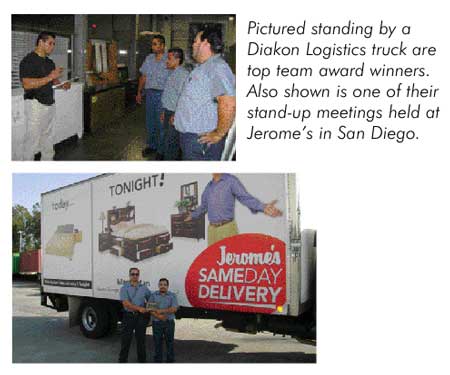CSA2010 regulations will affect furniture retailers, manufacturers, importers and specialized furniture carriers.
by Dan Bolger, P.E.
You probably don’t think of your company as a motor carrier but you are exactly that if you even operate one delivery truck with a gross vehicle weight registration over 10,000 pounds in 33 states or in interstate commerce. In reality, the federal requirements either apply or the state laws are similar. Whether you operate straight trucks or tractor semi-trailer combinations in commerce, you must pay attention to a new Comprehensive Safety Analysis (CSA2010) methodology that will increase your accountability for safety violations.
In essence, the previous safety ratings for furniture delivery trucks were reactive based on negative findings after crashes or audits, while the new Safety Management System (SMS) is intended to be proactive and systematically identify carriers and drivers that are below par. If your operation is cited and you fail to correct deficiencies, a process will ensue through steps resulting in the loss of licenses for drivers or a complete shutdown of your delivery operation. The seven Behavior Analysis and Safety Improvement Categories (BASICs) are shown in Sidebar #1.
Despite some false statements that have circulated throughout the transportation industry, CSA2010 doesn’t add new regulations. It does, however, change the scoring system. It is also important to understand that Federal Motor Carrier Safety Administration (FMCSA) regulations are the minimum requirements and not necessarily all you should be doing. CSA2010 simply increases the level of accountability for the transportation industry by making all violations count. This is a change from the current Safe Stat system that just scores more serious out-of-service violations. Possibly the most significant change is the potential loss of a driver’s license.
Overall CSA2010 will make the industry safer and is a positive initiative. CSA2010 is here to stay and will expand nationally later this year or early 2011. Compliance training is being done by company employees, outside consultants and with DVDs. Your implementation of CSA2010 may parallel the following examples or similar approaches to meet the requirements.
Getting Ready for CSA2010
Cory Home Delivery operates approximately 500 trucks daily in many states and has a corporate safety department headed by Director of Safety J. Scott Roberts, CIP, CDS. A process leading up to implementation of CSA2010 at Cory started two years ago with stepped up vehicle and driver inspections. A bonus program for clean inspections set the expectation that any violation is unacceptable. Negative results are tracked so struggling drivers are identified quicker and necessary action is taken. Investments in training and educating with safety seminars and monthly meetings for all managers have produced positive results. The Cory management team is far more educated and prepared for change through measurement and continuous improvement. While not yet legally required until the effective date, using the CSA2010 model well in advance provided insight for future compliance. Various on board technology is being evaluated to assist performance improvement.

Managing Partner Patrick Cory notes that most retailers are now reviewing the safety ratings of part of their transportation contracting process. Retailers are also recognizing that drivers must not violate the rules to cover for delays in the shipping department. CSA2010 brings additional accountability to each participant to the supply chain.

Resources for Onsite or Group Training
One furniture supplier that has done a good job of getting ready for CSA2010 is Coaster Company of America. The importer runs a private fleet of about 50 straight trucks and tractor semi-trailer rigs at various company locations. Coaster’s Human Resources Vice President Matthew Chen selected an outside consulting company, Vogel Safety & Risk, Inc., to conduct the training, Transportation associates from each location recently participated in Transportation Summit 2010 to achieve their training as a team with corporate staff over a two day period. Using a consultant jump started the effort well in advance of the effective date for the new rules.
Vogel Safety and Risk, Inc and similar companies offer on-site training for individual companies and group training each month at various locations throughout the USA. Other training companies, such as JJ Keller offer video training and related support materials. I do not endorse any specific training program but note them for introduction of the concepts.
In my experience, when serious trucking incidents occur, a careful analysis of a driver’s record often discloses a history of lesser incidents that should have resulted in driver retraining, license revocation or making an effort to repair equipment or cease operations. The bottom line is that at this point foward, every furniture retailer, manufacturer, importer or specialized delivery company that operates trucks must choose a method to educate themselves and their employees regarding legal and professional compliance with the updated governmental regulations.
Websites to Check For More Details
http://www.fmcsa.dot.gov/
http://csa2010.fmcsa.dot.gov/
http://www.vogelsafety.com/seminars-overview
www.jjkeller.com/csa2010
http://www.ai.volpe.dot.gov/
Sidebar #1: Behavior Analysis and Safety Improvement Categories (BASICs)
Unsafe Driving BASIC: Operation of CMVs in a dangerous or careless manner. Examples of violations include: speeding, reckless driving, improper lane change, and inattention.
Fatigued Driving (Hours-Of-Service) BASIC: Operation of CMVs by drivers who are ill, fatigued, or in non-compliance with the Hours-Of-Service (HOS) regulations. This BASIC includes violations of regulations surrounding the complete and accurate recording of logbooks as they relate to HOS requirements and the management of CMV driver fatigue. Instances related to the Fatigued Driving (HOS) BASIC are distinguished from incidents where unconsciousness or an inability to react is brought about by the use of alcohol, drugs, or other controlled substances. Example violations: HOS, logbook, and operating a CMV while ill or fatigued.
Driver Fitness BASIC: Operation of CMVs by drivers who are unfit to operate a CMV due to lack of training, experience, or medical qualifications. Example violations: failing to have a valid and appropriate commercial driver's license and being medically unqualified to operate a CMV.
Controlled Substances/ Alcohol BASIC: Operation of CMVs by drivers who are impaired due to alcohol, illegal drugs, and misuse of prescription or over-the-counter medications. Example violations: use or possession of controlled substances or alcohol.
Vehicle Maintenance BASIC: Failure to properly maintain a CMV. Example violations: brakes, lights, and other mechanical defects, and failure to make required repairs.
Cargo-Related BASIC: Failure to properly prevent shifting loads, spilled or dropped cargo, and unsafe handling of hazardous materials on a CMV. Example violations: improper load securement, cargo retention, and hazardous material handling.
Crash Indicator: Histories or patterns of high crash involvement, including frequency and severity. It is based on information from state-reported crash reports.
Source: Safety Measurement System (SMS) Methodology, FMCSA FMC-CSA-09-005
Daniel Bolger P.E. provides operations consulting services to clients throughout North America. FURNITURE WORLD readers can contact him at bolger@furninfo.com or phone 740-503-8875. For more information on transportation, logistics and furniture warehousing topics, go to FURNITURE WORLD’s website www.furninfo.com to read all of Dan’s articles.